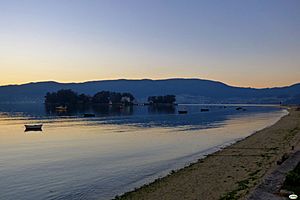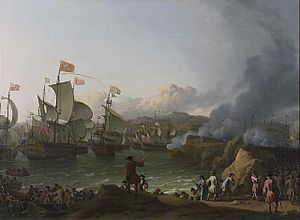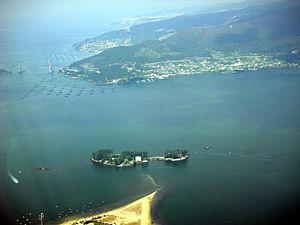Island of San Simón facts for kids
The Island of San Simón is part of a small group of islands called the San Simón archipelago. It's located in the Vigo estuary in Spain, along with the island of San Antón and other tiny islets. These islands belong to the area of Cesantes in the town of Redondela. As of 2021, no one lives on San Simón Island.
The island sits at the very end of the Vigo estuary, where water from towns like Redondela, Soutomaior, and Vilaboa flows in. A bridge connects San Simón to the San Antón. Together, these two islands are about 250 metres (820 feet) wide and 84 metres (276 feet) long. Close by are two even smaller islets, San Bartolomé and San Norberto. Over time, San Simón Island has been used for many different things: a monastery, a place for sick people (a lazaretto), a prison, and even an orphanage. Since 1999, both islands have been recognized as a special Historic Site.
Contents
A Look Back: History of San Simón Island
Early Times: The Middle Ages
San Simón Island was once a religious center in the Middle Ages. A famous poet named Mendinho wrote a song about it. This song is the only writing we know from him! To honor him, and other poets like Johan de Cangas and Martín Codax, busts (statues of their heads and shoulders) were placed on the island.
Sediam'eu na ermida de San Simón
e cercaronm'as ondas, que grandes son,
eu atendend'o meu amigo,
eu atendendo'o meu amigo...
Between the 12th and 13th centuries, the Knights Templar lived on the island. Later, a group of monks called the Franciscans, from the Paschaline order of Saint Simon, took over. But in 1370, this religious group was told to leave the island.
After being empty for almost 100 years, the area's religious leader, from Tuy, gave the island to Elizabeth the Catholic. This was a way to thank her for her loyalty. In 1589, English pirates, including the famous Francis Drake, attacked and robbed the island.
From the 1700s to the Spanish Civil War
In 1702, the waters near the island were the site of the Battle of Rande. During this battle, ships from Holland and England, who were fighting together in the War of Succession, tried to capture Spanish ships. These Spanish ships were carrying valuable goods from America. The battle ended with the Spanish and French forces losing. Many valuable items like gold, silver, diamonds, and spices were thrown into the sea to stop them from being stolen. However, much of the gold and silver had already been taken to Madrid before the battle. After the battle, the English and Dutch ships attacked nearby towns like Cangas de Morrazo, Redondela, Vigo, Sotomayor, and Arcade, burning and damaging them. San Simón Island was also attacked by British troops.
The church on the island, San Pedro, was almost completely destroyed but was rebuilt in the 1800s. People have searched for the sunken treasures around the island, but no gold or other precious materials have been found.
In 1719, Admiral Michelle entered the island. Later, during the Spanish War of Independence against Napoleon's French troops, the island faced more threats. Because of these dangers, the island was often left empty and then re-inhabited many times.
Monks liked to live on the island because of its beautiful location, its quiet isolation, and its closeness to the important monastery of Poyo. However, these attacks and robberies by foreign groups made the island and the whole region unstable. There were also local conflicts in Galicia called the Irmandiñas Wars. San Simón archipelago saw some of these fights, and a local leader named Fernando Andrade was badly hurt there.
From the mid-1600s, the island was abandoned. Then, in 1838, it was turned into a leper colony (a lazaretto). This was a place where people with serious diseases like leprosy were kept to prevent the illness from spreading. The island of San Antón was for those who were very sick, while San Simón housed the others. Having a lazaretto was very important for the port of Vigo, as it allowed ships from America to enter after being checked for diseases. This helped Vigo's port grow. Many outbreaks of cholera and leprosy coming from abroad were stopped here. The leper colony closed in 1927. It was then that the bridge connecting San Simón and San Antón was built, as before, the only way to travel between them was by sea.
The Spanish Civil War Period
Starting in 1936, during the Spanish Civil War, the island's buildings were used as a prison camp. This camp held people who were against the government led by Franco. At first, many prisoners came from nearby areas like Vigo and Pontevedra. Later, after the northern part of Spain was taken by Franco's forces, prisoners came from places like Asturias and the Basque Country. After the war ended, prisoners from all over Spain were sent there. It was officially called a "penitentiary colony," but it was truly a prison camp for people who held different political views, like communists, republicans, socialists, and anarchists. It stayed open until 1943.
The old buildings of the leper colony were then used to house the soldiers who guarded the island, and for offices or a hospital. Watchtowers were built, and the walls and entrances were made stronger for its new purpose.
The prisoners lived in very difficult and unhealthy conditions. Many political prisoners died on the island; it's thought that hundreds lost their lives, often at the hands of Franco's supporters. San Simón was known as one of Franco's most feared prisons. In 1941 alone, about 250 people died on San Simón.
Many survivors of the camp spoke about a priest named Father Nieto, who was known for being very harsh with the prisoners. He would often threaten and insult them, forcing them to attend religious services. One guard even said that after a shooting, Father Nieto would say cruel words to dying prisoners.
San Simón Island was featured in the ending of the film The Carpenter's Pencil. In the movie, a political prisoner is sent to the island, which was known as a place from which it was almost impossible to escape alive. The island also appeared in Agustín Fernández Mallo's 2021 book The Things We've Seen.
Buildings and Important Places
Buildings
The tallest building on the islands is called Residencia Stella Maris. It has a basement, a ground floor, and two upper floors. When the island was a lazaretto, it was used as a place for people to live. Later, when it was a prison, it housed offices and the warden's living area. Other buildings include the House of Sea Trades and Sailing School, an Aquarium, a Museum and Library, and a Multi-purpose Building.
Monuments
In 1991, the bridge connecting San Simón with San Antón was added to the list of important monuments in the Pontevedra province. Other notable spots include viewpoints of the estuary's entrance and end, the Chapel of San Pedro, the Paseo dos buxos (a path with boxwood trees), a path with ancient trees forming arches, and a monument honoring the famous writer Julio Verne.
See also
 In Spanish: Isla de San Simón para niños
In Spanish: Isla de San Simón para niños






